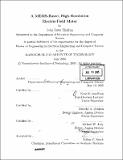| dc.contributor.advisor | Kent H. Lundberg, Timothy A. Denison and Michael W. Judy. | en_US |
| dc.contributor.author | Shafran, John Sawa | en_US |
| dc.contributor.other | Massachusetts Institute of Technology. Dept. of Electrical Engineering and Computer Science. | en_US |
| dc.date.accessioned | 2006-07-13T15:18:00Z | |
| dc.date.available | 2006-07-13T15:18:00Z | |
| dc.date.copyright | 2005 | en_US |
| dc.date.issued | 2005 | en_US |
| dc.identifier.uri | http://hdl.handle.net/1721.1/33358 | |
| dc.description | Thesis (M. Eng.)--Massachusetts Institute of Technology, Dept. of Electrical Engineering and Computer Science, 2005. | en_US |
| dc.description | Includes bibliographical references (p. 169-172). | en_US |
| dc.description.abstract | In MEMS-based inertial sensors, such as accelerometers and gyroscopes, known electrical waveforms are applied to a modulating capacitive element to determine an unknown deflection. However, the inverse of this scheme can also be exploited - the capacitive element can be deterministically modulated to measure an electrostatic variable. This thesis presents the design, analysis, and evaluation of such a sensor -a MEMS-based, high-resolution electrostatic field-meter (ESF) - using the Analog Devices iMEMS process. High-resolution sensing is achieved by optimizing the interface electronics for low-noise operation and applying feedback techniques to enhance the range-of-motion of the MEMS capacitive structure. The entire system consists of three components: the MEMS capacitive structure and two circuit subsystems - the sense block and the drive loop. The MEMS structure acts as a transducer to generate a dynamic current that is proportional to the magnitude and polarity of the electric field incident on the sensor. The drive loop is a closed feedback loop that modulates the MEMS capacitive structure at its resonant frequency to maximize its displacement and the magnitude of the dynamic current. The sense block ultimately converts the dynamic current into a dc voltage that is proportional to the magnitude and polarity of the incident electric field. The critical, front-end component of the sense block, a transimpedance amplifier, is implemented with a low-noise operational amplifier for optimum sensing resolution. | en_US |
| dc.description.statementofresponsibility | by John Sawa Shafran. | en_US |
| dc.format.extent | 172 p. | en_US |
| dc.format.extent | 8326823 bytes | |
| dc.format.extent | 8334061 bytes | |
| dc.format.mimetype | application/pdf | |
| dc.format.mimetype | application/pdf | |
| dc.language.iso | eng | en_US |
| dc.publisher | Massachusetts Institute of Technology | en_US |
| dc.rights | M.I.T. theses are protected by copyright. They may be viewed from this source for any purpose, but reproduction or distribution in any format is prohibited without written permission. See provided URL for inquiries about permission. | en_US |
| dc.rights.uri | http://dspace.mit.edu/handle/1721.1/7582 | |
| dc.subject | Electrical Engineering and Computer Science. | en_US |
| dc.title | A MEMS-based, high-resolution Electric-Field meter | en_US |
| dc.title.alternative | Microelectromechanical systems-based, high-resolution ESF | en_US |
| dc.type | Thesis | en_US |
| dc.description.degree | M.Eng. | en_US |
| dc.contributor.department | Massachusetts Institute of Technology. Department of Electrical Engineering and Computer Science | |
| dc.identifier.oclc | 62413777 | en_US |
